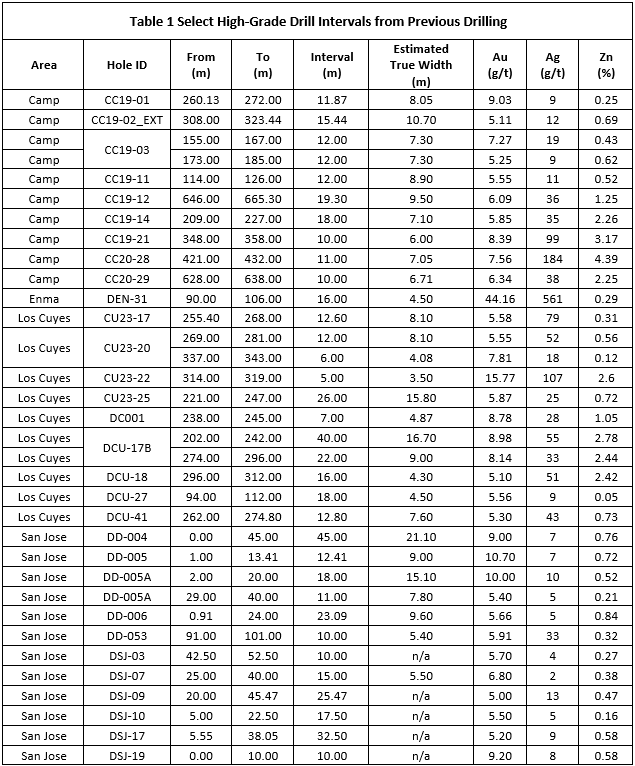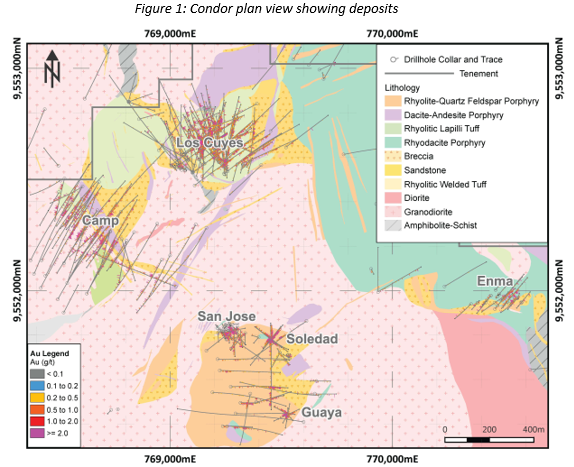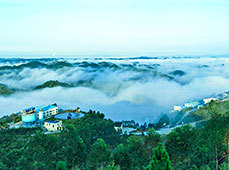Silvercorp Provides Plan to Develop the Condor Gold Project as a High-Grade Underground Mine
Trading Symbols: TSX/NYSE AMERICAN: SVM
VANCOUVER, British Columbia –December 4, 2024 – Silvercorp Metals Inc. (“Silvercorp” or the “Company”) (TSX/NYSE American: SVM) is pleased to report its plans to develop the Condor gold project (the “Project”), located in southern Ecuador. A preliminary economic assessment (PEA) was completed on the Project[1] by a previous operator, which outlined a high tonnage, low-grade, open pit gold project.
The Project comprises a cluster of gold deposits in the Condor North area (Figure 1), with Camp and Los Cuyes contributing the majority of the known mineral resources. Each deposit is unique and different from the others on a deposit scale. Previous drilling reported numerous long core intersections of gold mineralization, usually consisting of higher-grade intervals and surrounding lower-grade halos.
After reviewing the technical Project data, including re-logging of the historical core, the Company believes that high-grade gold mineralization mostly occurs in subvertical vein/rhyolitic dyke structures containing pyrite and sphalerite. Minor amounts of galena and chalcopyrite are also present and may form low grade halos, which can be quite extensive along certain volcanic layers.
Select drilling intercepts (Table 1), show higher-grade drill intervals with true widths over 3.5 metres (“m”). This highlights the potential for selective underground mining at Condor. Noteworthy intercepts include:
- Camp: CC19-01, 9.03 grams per tonne (“g/t”) over 8.05 m true width from 260 m
- Enma: DEN-31, 44.16 g/t Au over 4.5 m true width from 90 m
- Los Cuyes: DCU-17B, 8.98 g/t Au over 16.7 m true width from 202 m
- San Jose: DD-004, 9.00 g/t Au over 21.1 m true width from surface
[1] Condor Project NI 43-101 Report on Preliminary Economic Assessment Zamora-Chinchipe, Ecuador, July 28, 2021, filed under Luminex Resources on Sedar+
Development Plan for a Possible Underground Operation
In order to advance the Condor gold project as an underground operation, the Company will focus on high-grade gold structures/rhyolitic dykes. Work to be conducted may include:
- Studies and Permitting
- Re-estimate mineral resources as an underground focused operation.
- Publish a Preliminary Economic Assessment as an underground mine operation.
- Execute community agreements and complete government permitting process in order to develop exploration tunnels.
- Underground Tunneling
- Develop two cross-cut exploration access tunnels, at two different elevations, to confirm the high-grade gold intervals.
- Conduct underground drilling to inform a future feasibility study and to improve the understanding of the geology.
- Construction Readiness
- Complete a feasibility study based on the data gathered from the underground tunneling program.
- Complete permitting for a process plant, underground mine and tailings storage facility.
- Construction decision.
- Drilling:
Limited drilling will target the high-grade mineralized structures by optimizing the grid pattern and could include:
- Infill drilling: Targeted between previous drill sections to confirm the continuity of high-grade mineralized structures.
- Step-out drilling: Targeted along strike and dip of known high-grade zones to increase the mineral resource.
- New targets:
- Broad zones of sub-horizontal disseminated gold mineralization which occur within the rhyolitic tuffs at Los Cuyes.
- Contact zone of crypto rhyolite domes with batholith granodiorite for wide mineralization at Camp.
- Region between the Camp and Los Cuyes deposits.
- Gap area between Camp and Soledad, testing for potential connection of NW trending mineralized structures across the two deposits and for potential strike extension of NW trending mineralized structures.
- Gap between the Los Cuyes and Enma deposits for potential strike extension of NW trending mineralized structures.
- Test expansion potential of near-surface, high-grade breccia deposits such as San Jose/Soledad.
Deposit Descriptions
The Condor deposits are hosted in a Cretaceous volcanic complex of diatremes and rhyolite/dacite intrusives crosscutting the Zamora batholith granodiorite of Jurassic age. The Project consists of the following five known deposits:
- Los Cuyes: Gold is hosted in a volcanic diatreme which crosscuts a granodiorite batholith. The diatreme, with a dimension of 450m in NE-SW x 300m in NW-SE x 350m depth comprises phreatomagmatic breccias, tuff and sediments, all of which are cross-cut by NW and NE striking dykes of rhyolite and dacite. Gold mineralization mostly occurs in subvertical vein structures containing pyrite and sphalerite with minor amounts of galena and chalcopyrite. The vein-like mineralisation primarily occurs along the contact zones of intrusive dykes with the surrounding volcanics and Granodiorite batholith. In addition, gold is also associated with sulfide dissemination occurring in rhyolitic tuff units, resulting in wide sub-horizontal zones of gold mineralization.
- Camp: Gold mineralization occurs within veins of pyrite/sphalerite and is controlled by NW striking rhyolite dykes at shallow levels, as well as crypto intrusive domes of rhyolite at depth. Gold mineralization remains open beyond a depth of 700 metres based on existing drill data.
- Soledad: Gold mineralization is associated with pyrite/sphalerite replacement of feldspar grains (patchy) or veins hosted in a rhyodacite porphyry. At San Jose, gold mineralization consists of sphalerite-rich veins hosted in phreatomagmatic breccia.
- Guaya: Gold mineralization is associated with pyrite-sphalerite veins hosted in a rhyo-dacite porphyry.
- Enma: Gold mineralization occurs within veins of pyrite/sphalerite hosted in the rhyolitic breccia along the contact between dacitic tuff and granodiorite batholith.

Note:
1). The compositing of drill intercepts is done using a cut-off grade of 2g/t gold, may include lower grade samples within.
2). True width is estimated based on the current interpretation of mineralized structures.
3). n/a - no adequate information to make estimate of true width

Qualified Person
The scientific and technical information contained in this news release has been reviewed and approved by Alex Zhang, P. Geo., technical consultant of Silvercorp (the “Qualified Person”), who is a qualified person under National Instrument 43-101 Standards of Disclosure for Mineral Projects (“NI 43-101”) for the purposes of NI 43-101.











